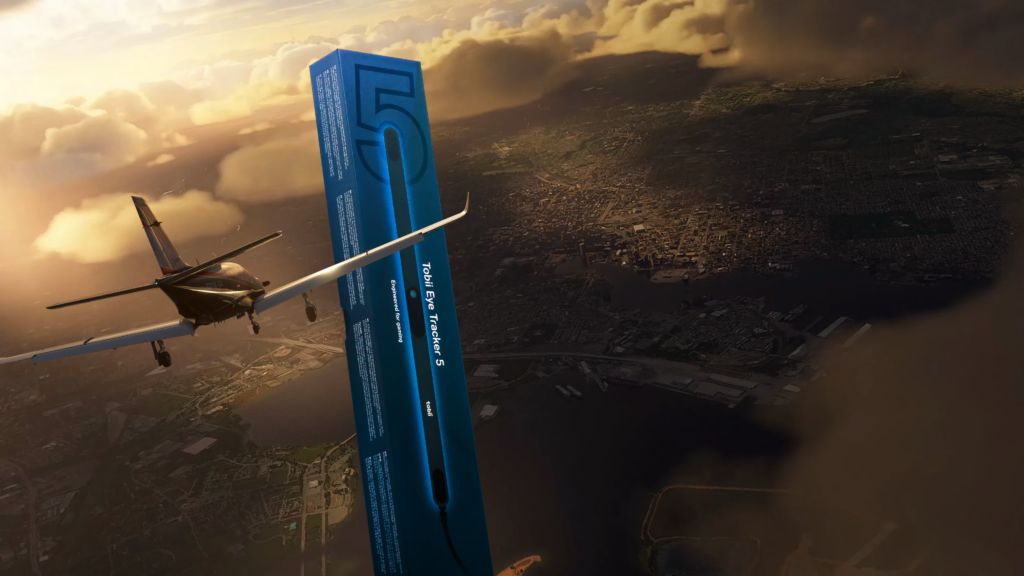The Microsoft Flight Simulator team will be attending FlightSimExpo in Houston, Texas from June 23-25! If you’re at the expo, be sure to stop by our booth in the Waltrip Hangar to meet the MSFS Team and try some great products from some of our hardware partners.
Today we’re pleased to highlight one partner who is providing head/eye tracking peripherals to our booth kiosks: Tobii.
If you’re a PC simmer looking to improve your situational awareness and add a higher degree of immersiveness to your Microsoft Flight Simulator experience, consider adding a Tobii Eye Tracker 5 to your hardware setup. Featuring both eye tracking and six degrees of freedom (6DoF) head tracking, the Eye Tracker 5 gives simmers natural and intuitive camera control in Microsoft Flight Simulator just by moving their head and eyes to check their instruments or look around outside the aircraft.
Controlling the camera in Microsoft Flight Simulator with an Eye Tracker 5 is like having a hands-free mouse look mode without the mouse! Best of all, it’s not necessary to attach an IR transmitter to your head; the Tobii Eye Tracker 5 seamlessly tracks your head and eye movements without any other accessories.
Attendees of FlightSimExpo will have the opportunity to not only experience hands-free camera control with a Tobii Eye Tracker at the Microsoft Flight Simulator booth, but to also potentially win one themselves! Stop by the Microsoft booth to pick up a special Bingo card then complete fun activities throughout the expo. On Sunday, we’ll conduct a random draw out of all the completed Bingo cards, with two lucky winners taking home an Eye Tracker 5.
We also caught up with Microsoft Flight Simulator Twitch streamer and Tobii ambassador CaptArash to talk about his experiences in the sim and with the Tobii Eye Tracker 5.
Tell us a little bit about yourself and how you got started in the flight simming hobby.
I’ve been fascinated by aviation since I was very little. My dad, who is now retired, spent his entire professional life working for an airline, so in our household conversation about airplanes was a common occurrence. My bedroom’s walls were always covered by the posters of aircrafts and their cockpits that my dad used to bring for me, and I had numerous models of my favorite airliners on bookshelves and other places.
My first ever experience with a flight simulator goes back to my childhood playing with a very primitive sim on a Commodore 64. I can’t remember which company was the developer though. I always thought I would become a pilot, but during high school I started needing to wear glasses. That’s not an issue these days; however, where we used to live, flight schools were not accessible like here in North America, and they were only selecting people with 20/20 vision as one of their requirements. Basically, my dream of becoming a pilot was unreachable due to the circumstances of the time.
Despite the obstacles, my dream of flying never ceased, and I’ve been using flight simulators since my father purchased our first Windows PC back in 1997. I also managed to get my hands on the old Microsoft Flight Simulator 4.0 on a floppy disk which I borrowed from my cousin. I remember I used to spend hours on that version of the sim learning about the basics of flight and aircraft instruments, especially VOR and ILS. That year FS98 was also released, and I bought a copy of it, and I still have its original CD. That sim was truly an amazing advancement compared to FS4.0.
From there, every new version of Microsoft Flight Simulator has been must-have software on my PCs, and gradually I started learning more and more about aircraft systems, how they work in real life, realistic operations, and reading navigation charts. I was mostly interested in airliners though. I think mainly because the scenery of the old flight sims were not realistic enough. That changed drastically though when I first watched the trailer for the new Microsoft Flight Simulator back in 2019. That trailer blew my mind, and the first thing I thought was that I can finally explore the world virtually in a small plane instead of only focusing on an airliner’s systems.
I thought I could focus on the true nature of flight, looking outside, and navigate my way around using rivers, lakes, and mountains. Basically MSFS (2020) changed the playground for me completely, so much so that in our communities, everyone knows me mostly as a GA flight simmer. Also, now that wearing glasses is not a limiting factor, I want to take what I’ve learned in our virtual world to the real one and get my PPL (at least) and make my dream of becoming a pilot a reality, not as a career necessarily, but as a fun hobby. Who knows what life holds in the future!
For over two years, you’ve been virtually flying around the world in a Cessna 172 without the use of GPS or other modern navaids. What can you tell us about this journey?
I believe the old school navigation is an art which is getting forgotten and we need to make sure to learn and preserve it and pass it on to the next generations. Like most of us, when I started my flight around the world, I was using the onboard GPS of my C172 steam gauge version, mainly because I didn’t want to get lost while I was streaming my journey and embarrass myself; however, since I knew the basics of VOR navigation, I was using it independently to see if I can truly rely on the old school instruments and other navigation methods to get the same results.
It didn’t take too long until I gained enough confidence in my navigation skills that I completely ditched GPS and continued my journey only using VFR charts, old ground-based navaids (if they are available in the area), or celestial navigation (using the Sun, Moon, or stars) if no other methods are available or practical. The latter is a new skill that I was fortunate to learn from one of our community members who is known as Celestial Navigator. The old school navigation basically has become the staple of my GA flights to a point that my partner gave the name of “Compass Club” to my Twitch viewer community. It’s been one of the most fascinating and rewarding experiences I’ve had in a long time. I have learned a tremendous amount about different navigation techniques and instruments, and it has opened my eyes to how aviators and sailors used to navigate the world.
Also, it has brought me a new level of appreciation for what we have achieved technologically. Yes, GPS has become an essential part of aviation in the modern era, but I think in order to truly understand and appreciate it, we need to be able to understand and use older techniques. I can compare it to mathematics. We all use calculators even for the basic operations; however, if you ask any math teacher, they all emphasize learning basic skills. Solving mathematical problems without a calculator forces us to think critically and logically about the best approach.
I believe not relying on GPS as the only navigation instrument will help us to have a better situational awareness in critical scenarios when something goes wrong, like an instrument failure, data error, or infrastructure outages. We all know that having redundancy is a critical concept in aviation and I think we need to emphasize redundancy in navigation methods, rather than phasing out the older ones. Plus, it’s a heritage that we need to keep alive! Like any useful language or skill. We never know when they can become a life saver.
How does the Tobii Eye Tracker 5 enhance your Microsoft Flight Simulator experience?
I talked about situational awareness earlier while flying, which is something that is naturally limited in a flight simulation software, as we are looking at our monitors (unless we use a VR headset, which is not always practical and is also very pricey); however, with Tobii Eye Tracker 5 I can overcome that limitation, by quickly turn my head around, get closer to my instruments, or look up above my dash to see what’s in front of me on the ground. This is very crucial for me during taxi, departure, flying in traffic patterns, approach, and landing, as I need to quickly switch my gaze between my instruments and outside without relying on my mouse and controllers.
Not only it can pan the camera around with my head and/or eye movements, but also its six degrees of freedom allows me to move the camera forward/back, left/right, and up/down with my head movements. I never knew how important it is to have those hands-free movements until I used a head tracker. And now with Tobii, I can seamlessly have those freedoms without even thinking about them. Before Tobii Eye Tracker 5, I was using a different product which was good but limited in terms of software and hardware requirements.
The huge advantage of Tobii Eye Tracker 5 is that it doesn’t require any infrared emitter or reflector attached to your head or headphones. Also, Tobii’s software seamlessly works with Windows and upon launching MSFS. I only needed to tune some parameters once. Sometimes I even forget that I actually have Tobii running in the background until I spawn in my plane and the camera starts moving around with my head movements. The fact that I can use it wirelessly and without any emitter or reflectors attached to me is truly a quality-of-life feature.
CaptArash will be attending FlightSimExpo in Houston from June 23-25. If you see him wandering around the convention floor, be sure to say hello! He loves meeting other passionate flight sim fans. When not at the expo, you can find him streaming Microsoft Flight Simulator on his Twitch channel. He will also be joining our Community Fly-In Friday panel on the MSFSOfficial Twitch channel as a guest co-host on Friday, June 30 at 1800Z.

